We walked to the meadow on Friday for the first time since last fall. The little parking lot off Middle Road was waiting for us, our wardrobe to Narnia.
To begin the walk, you must first ascend a steep path under a bower of pines. The towering trees parse the late sun into glints and baubles; a thick bed of pine needles is soft underfoot. Soon you descend into a cool, quiet valley of great fallen oaks and ferns unfurling. Wild hazelnuts are leafing out; the understory is a carpet of bushy huckleberries. A winding stone wall, held together by time and lichen, keeps track of you as it once did sheep, propelling you in the right direction.
On Friday, as we neared the fork in the trail and the opening in the trees, I worried the meadow might not be as magical as I remembered it. Too early for dragonflies. The goats likely wouldn’t be hanging around. What if the field grasses weren’t thick and golden, undulating in the breeze?
I needn’t have worried; there is something other-worldly about this wide-open meadow, and I felt it again, right away. Of course, part of that feeling arises from how you get here – you come to this place on foot, not by car. It feels hidden. When you walk from the dark woods into brilliant light, you can feel a gear shift, a burden lift. The view stretches far ahead of you, clean and (mostly) unfettered. What you do see, if you look as far as you can in every direction, is that you are surrounded on all sides by higher ground, tall trees, and slopes studded with rocks. You are in a valley. It feels like a safe haven and yet it also feels a bit like the moon.
The moon – yes, that’s it! It’s the rocks, I suddenly realized this time. The very big rocks, otherwise known as erratics, lying about in the field, scattered randomly by fate. Without the dragonflies and the goats and the summer sun to distract, the erratics come into focus and demand your attention.
You stop, filled with wonder and curiosity, and consider these foreign objects, seemingly out of place. One looks like a porpoise diving, another looks like a crocodile.
These rocks are thousands, probably millions of years old, left behind when the glaciers began to recede from Martha’s Vineyard about 20,000 years ago. In fact, the inverted-V shape of the Island is the result of two receding glaciers to the northwest and northeast leaving behind the rocky moraines that form the north edges of the Island. These are called terminal moraines. (Where I live, in the south central area of the Island, the geology is described as sandy outwash plain, formed by melting glacial water leaving sediment behind.)
I must admit, my fascination with this kind of rock starts with its name: erratic. Just pronouncing it is delightful. And next, its definition (or definitions). You might not have known that erratic (i-‘ra-tik) is a noun, in addition to being an adjective.
Erratic (i-‘ra-tik)
Adjective:
1. Having no fixed course, wandering
2. Characterized by lack of consistency, regularity, or uniformity or deviating from what is standard or ordinary
3. Transported from an original resting place, especially by a glacier
4. (archaic) Nomadic
Noun:
1. One that is erratic, especially a boulder or block of rock transported from its original resting place especially by a glacier
Also: Erratical, Erratically, Erraticism
I find it amusing to think of these big stones acting erratically. But when you think about the root of erratic – it comes from the Latin verb errare (“to wander”) and is generally interpreted as wandering off course, or straying — you have new respect for the journey these hunks of granite took, hitchhiking on ice sheets many times taller than the tallest skyscrapers, possibly traveling all the way from the White Mountains of New Hampshire. When at long last they broke free of the receding glaciers (well, okay, they were dumped), these proud and noble formations took up their positions and went to work. After a nomadic life of wandering and deviating from the normal course, they put down roots, so to speak (there’s hope for us all!) on Martha’s Vineyard.
Some, like the most well-known erratic on Martha’s Vineyard, Waskosim’s Rock, became boundary markers – in this case for the line between English and Wampanoag lands in the 1600s. Others provided lookouts, like the rock at Prospect Hill looking out over Vineyard Sound and the Elizabeth Islands. And of course, many of the smaller ones were “repositioned” – dragged by oxen and men to form the stone walls so ubiquitous in up-Island Martha’s Vineyard.
But one of the most generous qualities of an erratic is how they invite us to play. As Adam Moore, executive director of the Sheriff’s Meadow Foundation, wrote in a Vineyard Gazette piece called “Ecstatic for Erratics” some years ago, “[Erratics] call out to be climbed. They offer a challenge, and an exhilarating feeling to those who scramble to the top.” To this day, children and adults alike clamber up the largest erratics on Martha’s Vineyard. When I first came to the Island, I was immediately drawn to climbing the rocks I encountered on trails and on the North shore beaches, and I still do it, childlike as it is.
I’m not sure I ever feel as close to nature as I do perched on one of these rocks – though I am known to climb a tree from time to time. But there is something both grounding and energizing about sitting on a rock. If I sit quietly, I can feel a connection to a spirit both deep within me and outside of me. To that extent, it is fair to say that erratics have been integral to the serenity I’ve found living on Martha’s Vineyard.
One of the nicest things about visiting the meadow is also leaving it. Because we don’t turn around and walk in the way we came; we exit at the other end, walking up a hill, first to a lookout outfitted with a wooden bench, and then higher, to an overlook with an erratic the perfect size for scrambling and perching. And from there, we continue on our circuitous route, which takes us right past Waskosim’s Rock on the way back to the car.
On Friday, we didn’t climb Waskosim’s, we just stopped to gaze, remarking again how much it looks like the mouth of a whale. We noticed the squirrels had spent the winter banking their acorns in the crevice between the two stones. We patted the lichen-covered stone and felt its warmth and strength, knowing it would be there for us whenever we come back.
💚





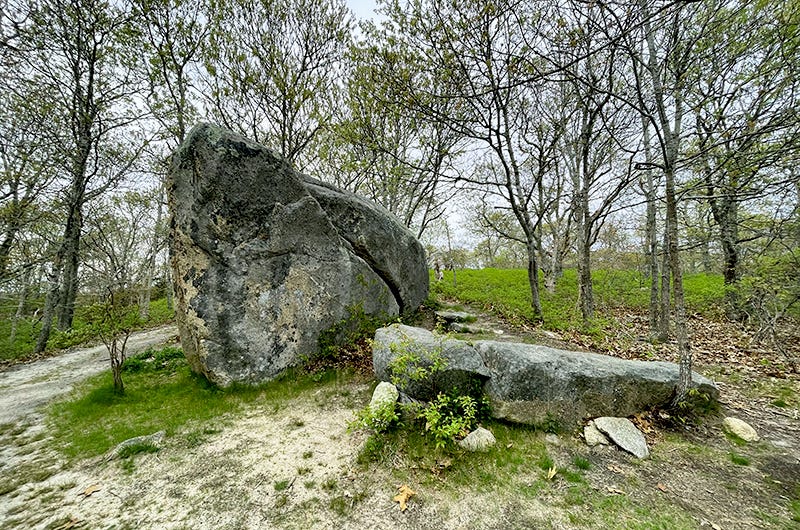
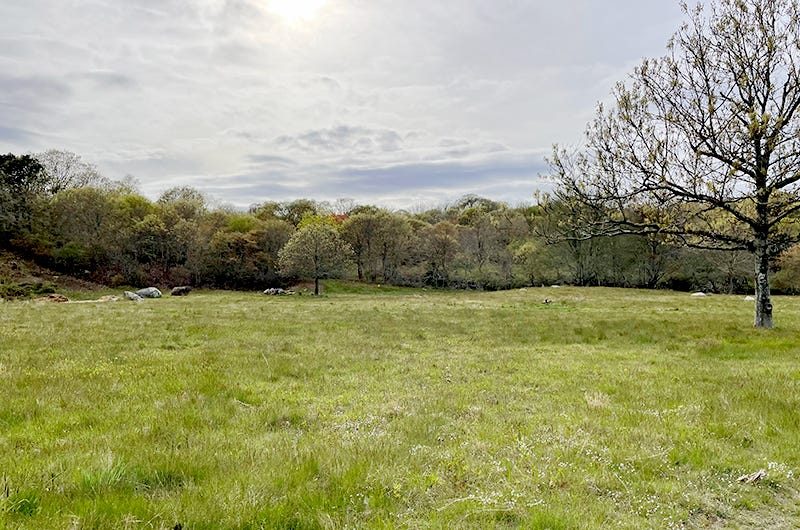
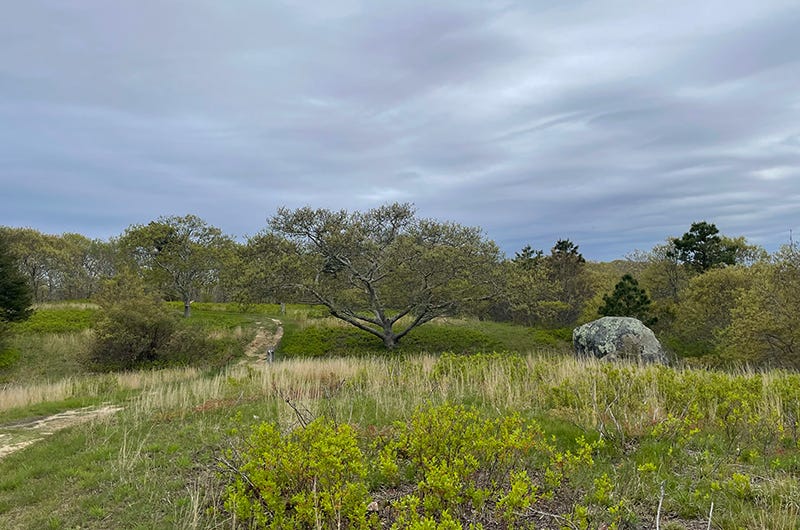
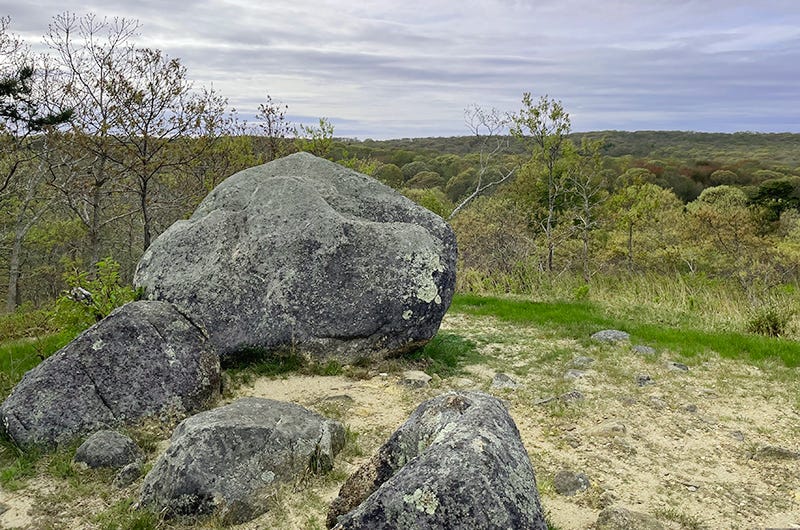
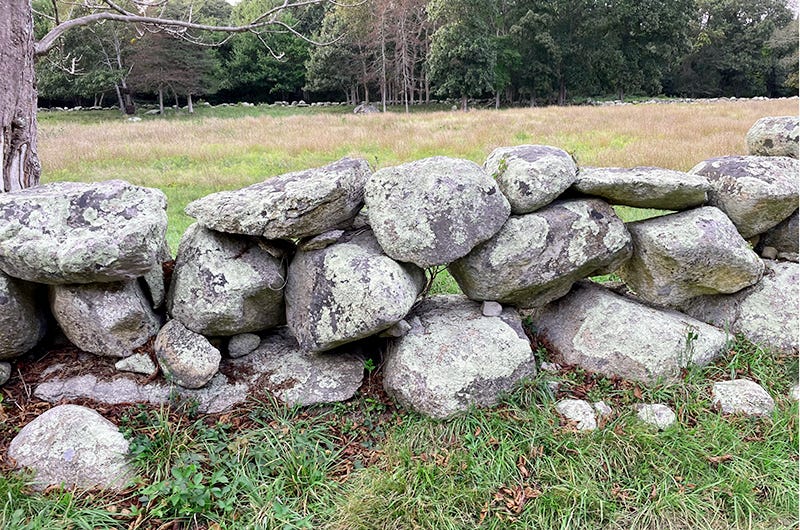
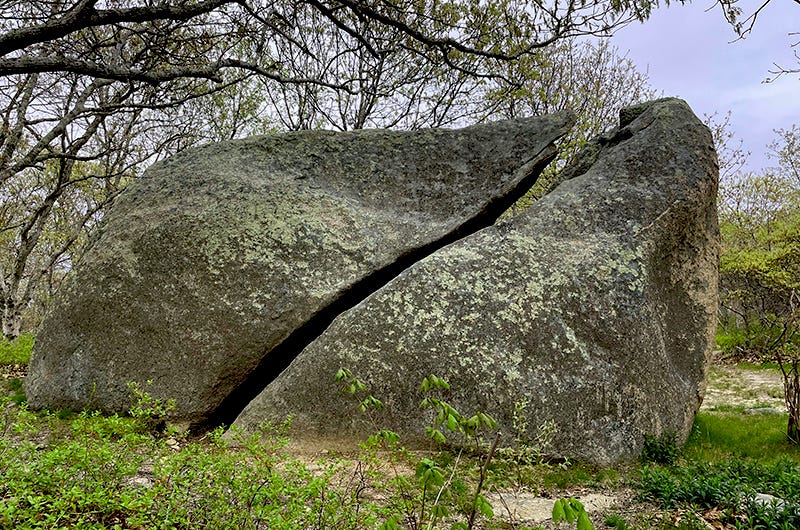
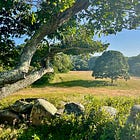
Very cool Susie. I did not know about erratic rocks or the origins of the island. 😉
Having spent much time in the mountain ranges of the US I’ve always been fascinated by how rocks end up where they did—and also the sheer toil of the men who built miles and miles of rock walls centuries ago.
Thanks for giving your MV rocks a personality 👏👏
Beautiful! What a brilliant essay, and I re-learned about the erratics dropped by our own glaciers here on the Olympic Peninsula of the Pacific Northwest. Yes, these ancient stones seem to impart warmth and wisdom.